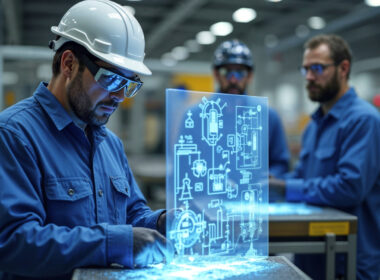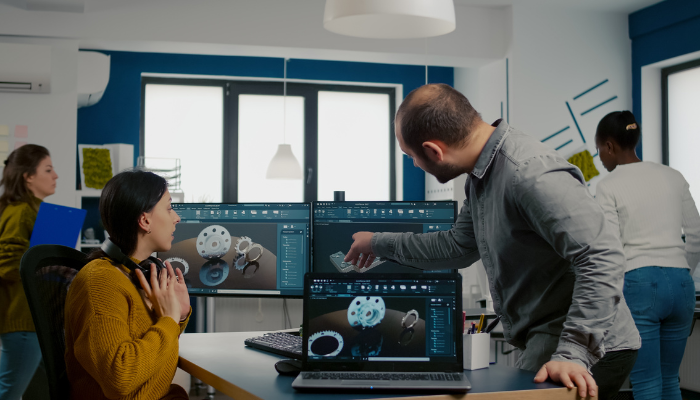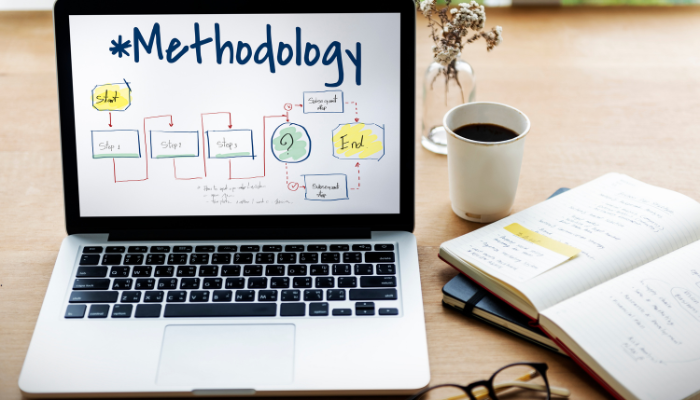Ever heard the saying, “You can’t judge a book by its cover“? Well, apparently, most people do! A recent study found that a whopping 75% of users judge a company’s credibility based on design. That’s right—the way your website or product looks can make or break your brand.
Think about it. When you visit a website that’s cluttered, confusing, or just plain ugly, how likely are you to stick around? Not very, right? On the other hand, a well-designed website or product can leave a lasting impression and even inspire loyalty.
In this blog, we’ll look at some iconic product design examples—both digital and industrial—and see what makes them stand out. You’ll discover how these designs have set new benchmarks and changed industries.
Let’s dive into some creative insights that might just spark your next big idea!
The Power of Product Design: Why It Matters More Than Ever
Product design is more than just skin deep. It’s the invisible force that shapes how users interact with a product and ultimately determines its success.
A recent study found that 83% of people appreciate a website that looks attractive and up-to-date. And 91% of users value both product descriptions and visuals equally. That’s a clear sign that good design is crucial for customer satisfaction.
Characteristics of Good Design
What makes a product design really stand out? Let’s break it down.
1. Usability
A great product should be easy to use, like a well-worn pair of sneakers. If users can figure things out without breaking a sweat, they’ll stick around and keep coming back for more.
2. Intuitiveness
The best designs seem to know what you want before you do. When everything flows smoothly with clear actions, it makes the whole experience better.
3. Marketability
A sleek, well-designed product is much easier to sell. Eye-catching visuals and smooth functionality will grab attention and give you an edge over competitors.
4. Customer-Centric Design
It’s all about balancing what your users need with your business goals. Listen to your customers, tweak your design to meet their expectations, and you’ll hit the jackpot.
5. Consistency
Ever notice how a familiar layout makes you feel more comfortable? Sticking to the same fonts, colors, and overall look across platforms helps build trust and keeps things easy to use.
6. Accessibility
Great design includes everyone. Making sure your product works for people with different abilities—like using readable fonts or making it easy to navigate with a keyboard—means you reach a wider audience.
7. Aesthetics
Let’s face it, looks matter. A visually pleasing design creates an emotional connection and makes users enjoy the product more.
8. Innovation
Good design isn’t just about looks—it’s about offering something fresh. Innovation, whether through cutting-edge tech or unique features, keeps users excited and coming back for more.
The secret sauce to successful product design? It’s finding the perfect balance between meeting customer needs and achieving commercial objectives. This means understanding your target market, conducting user research, and iterating on your designs based on feedback.
When you blend usability with aesthetics, accessibility, and a touch of innovation, you get a design that doesn’t just meet expectations—it exceeds them.
Also read: Understanding the Product Design Process and its Key Stages
Now, let’s take a look at some iconic digital product designs that have redefined user experiences.
Iconic Digital Product Designs: A Closer Look
Digital product design has come a long way in recent years. From the early days of clunky interfaces to the sleek and intuitive designs we see today, there’s been a remarkable transformation.
Let’s explore some of the most iconic digital products and their product design examples, along with the design principles that have made them so successful.
1. Spotify: Personalization and Continuous UI Experimentation
Remember that time you were feeling down and Spotify magically cued up a playlist of your favorite feel-good songs? That’s the power of personalization. Spotify’s algorithm is like a personal DJ, learning your tastes and recommending new music that you’ll love.
But Spotify doesn’t stop there. They’re constantly experimenting with new features and layouts, showcasing impressive product design examples to make the app even better. It’s like having a friend who’s always trying to improve themselves.
2. Airbnb: Advanced Search Options and Simplified User Journeys
Remember the days when planning a trip meant sifting through countless travel guides and websites? Airbnb changed all that. Their advanced search options are prime product design examples that allow you to filter your search by location, price, amenities, and even the type of accommodation you’re looking for. It’s like having a personal travel agent at your fingertips.
Once you’ve found your perfect stay, Airbnb’s simplified user journey makes it easy to book your accommodation. The platform provides clear instructions and helpful information at every step of the process, ensuring a hassle-free experience.
3. Netflix: Smart Categorization and Artwork Personalization
Netflix knows exactly what you want to watch, even before you do. Their algorithm is one of the best product design examples out there, as it can recommend movies and TV shows that you’ll love based on your viewing history. Whether you’re in the mood for a comedy, a drama, or a sci-fi thriller, Netflix has you covered.
But what really sets Netflix apart is its artwork personalization. The platform uses algorithms to select artwork that is most likely to appeal to you, based on your viewing history. This makes it more likely that you’ll click on a particular title and start watching.
4. Stripe: Seamless Navigation and Organized Documentation
Stripe is a payment processing platform that is loved by businesses of all sizes. One of the reasons for its popularity is its intuitive interface, which stands out as one of the key product design examples. The platform is designed to be easy to navigate, even for users who are not tech-savvy.
In addition to its user-friendly interface, Stripe also provides comprehensive documentation and support. This makes it easy for businesses to get started with the platform and troubleshoot any issues that may arise
5. Google Search Bar: Simplicity and Intuitiveness
The Google Search Bar is so simple, yet so powerful. It’s one of the most notable product design examples, functioning like a knowledgeable friend who can answer any question you have.
Just type in your query, and Google will deliver relevant results in a matter of seconds. The search bar’s minimalist design ensures that the focus remains on your search, not on the interface.
6. TikTok: UI Influenced by Fitts’s Law and Swiping Principle
Image by Freepik
TikTok has taken the world by storm with its addictive short-form video content. But what makes TikTok so engaging? It’s the user interface. TikTok’s design is influenced by Fitts’s Law, which states that it’s easier to move a pointer to a target that is larger and closer.
This means that elements on the screen are positioned in a way that makes them easy to tap or swipe. This thoughtful arrangement is one of the key product design examples that enhance user experience. The swiping principle also makes it effortless to navigate between videos.
7. Miro: Intuitive Layout Promoting Smooth Teamwork
Collaboration can be challenging, especially when working remotely. Miro has made it easier than ever for teams to work together on projects. The platform’s intuitive layout and drag-and-drop functionality are standout product design examples, making it a breeze to add and organize elements on the board. Features like voting and commenting help teams stay on track and make decisions efficiently.
Now, let’s shift our focus to some iconic industrial product designs that have become timeless classics.
Iconic Industrial Product Designs: Timeless Classics
Industrial product designs blend function and style, making everyday items more enjoyable to use. From innovative lighting to clever packaging, great design changes how you interact with products.
Let’s explore some iconic product design examples that have truly made an impact and improved our daily lives.
1. Anglepoise Lamp: A Flexible Friend
Image by Freepik
The Anglepoise Lamp is more than just a light fixture; it’s a flexible friend that can be adjusted to any position you need. Imagine trying to read a book in a dimly lit corner without being able to move the light.
It’s a frustrating experience, isn’t it? That’s where the Anglepoise Lamp comes in. This standout among product design examples features a unique spring-loaded mechanism that allows you to easily adjust the lamp to provide the perfect lighting for any task.
2. Heinz Ketchup Bottle: A Squeeze of Genius
The Heinz Ketchup Bottle is another iconic example of industrial product design. The distinctive shape and the bottom hole that allows ketchup to flow out easily have made it a household name.
But have you ever wondered how this simple yet ingenious design became one of the most notable product design examples? It turns out that the bottle was the result of a competition held by Heinz in the early 1900s. The winning design was so successful that it has remained virtually unchanged for over a century.
3. Bic Ballpoint Pen: A Writing Revolution
The Bic Ballpoint Pen is a simple yet ingenious invention that has revolutionized the way we write. Before the ballpoint pen, writing was a messy and time-consuming process that required dipping a pen into an inkwell.
The ballpoint pen, on the other hand, is easy to use and provides a smooth, consistent writing experience. It’s no wonder that the Bic Ballpoint Pen has become one of the iconic product design examples, serving as a staple in offices, schools, and homes around the world.
4. KitchenAid Stand Mixer: A Kitchen Workhorse
The KitchenAid Stand Mixer is a versatile kitchen appliance that has been around for over 100 years. As one of the standout product design examples, it’s a true workhorse that can handle a variety of tasks, from mixing dough to whipping cream. The mixer’s robust construction and rotating motion make it a reliable and efficient tool for any home cook.
5. Polaroid SX70 Camera: Capturing Moments in Time
Image from Amazon
The Polaroid SX70 Camera was a groundbreaking invention that introduced the world to instant photography. Imagine being able to take a photo and see it develop right before your eyes. That’s the magic of the SX70.
The camera’s folding design and high-quality images made it a popular choice for photographers and consumers alike. As one of the notable product design examples, the SX70 helped to popularize instant photography and paved the way for future innovations in the field.
6. Dyson Vacuum Cleaner: A Revolution in Cleaning
Image from Freepik
Dyson vacuum cleaners are known for their innovative design and powerful suction. The company’s cordless vacuum cleaners have been particularly successful, offering users the convenience of cordless cleaning without sacrificing performance.
Dyson’s vacuum cleaners are standout product design examples, featuring a unique cyclone technology that separates dirt and dust from the air, resulting in cleaner floors and carpets.
7. Apple Watch: A Stylish Companion
The Apple Watch is a standout among product design examples, combining technology with style. This popular wearable device features various functions, including fitness tracking, notifications, and app compatibility. Its sleek design and user-friendly interface have made the Apple Watch a top choice for consumers looking to stay connected and active.
Now, let’s turn our attention to the latest design trends and considerations that shape the future of product design.
Design Trends and Considerations in Product Design
When you think about product design examples, keeping up with the latest trends is essential. By understanding what’s popular in design today, you can create products that really connect with users.
Let’s dive into some key trends shaping product design.
1. Minimalist Interfaces and Predictable UIs
Today, less is more! Users love simple interfaces that focus on what’s important. By stripping away unnecessary elements, you help users find what they need quickly. Predictable UIs make navigation smooth, ensuring users can easily achieve their goals. Isn’t it nice to use an app that feels easy to understand?
2. Balancing Looks, Functionality, and Emotions
Great design isn’t just about how a product looks. It’s about finding a balance between style, usefulness, and emotional appeal. A product that looks good catches the eye, but it also needs to work well.
Plus, when users feel an emotional connection to a product, they’re more likely to stick with it. Think of how Apple blends beautiful design with powerful features, making their products so appealing.
3. Encouraging Accessibility and Customization
Design should be for everyone. Making your products accessible means everyone can use them, no matter their abilities. This could include features like adjustable text sizes or easy navigation options. Plus, when you allow users to customize their experience, they feel more connected to your product. Catering to diverse needs can boost overall satisfaction.
4. Sustainability and Eco-Friendly Practices
People today care about the planet. Using sustainable materials and practices in your designs isn’t just a trend; it’s crucial. Brands that prioritize eco-friendliness attract customers who want to make a positive impact. Look at Patagonia—they create products with minimal environmental impact and attract eco-conscious shoppers.
5. Smart Technology Integration
Smart tech is changing how we interact with products. By adding IoT (Internet of Things) features, you can make products that connect and communicate. Whether it’s a smart thermostat that learns your habits or an appliance you control with your phone, these innovations make life easier.
6. Data-Driven Design Choices
Using data can guide your design decisions. Analyzing user behavior helps you understand what works and what doesn’t. For instance, A/B testing shows you which designs users prefer. This way, you can refine your product based on real feedback.
7. Visual Hierarchy and Clarity
A good design uses visual hierarchy to guide users. This means arranging elements to highlight important information. Using size, color, and spacing helps draw attention to key actions. When users can easily see what to do next, their experience improves.
Why Choose Codewave for Your Customer Experience Design?
When you’re looking for amazing product design examples, Codewave is here to lead the way in design thinking-led digital innovation. We focus on every part of the customer journey to make sure your products connect emotionally with users and drive real results.
Here’s how we can help you elevate your customer experience (CX) design:
- Emotional Design: We really get to know your customers. By understanding their feelings and online behaviors, we create products that resonate with them and make them feel valued.
- Adoption: Our onboarding experiences are crafted to activate customers in seconds. With user-friendly designs, they can start using your product right away and have a great first impression.
- Engagement: We focus on designs that keep users coming back. By ensuring a smooth experience, we encourage repeat visits and lasting connections.
- Gamification: We add fun to the customer journey through gamification techniques. This makes interactions enjoyable and helps build loyalty over time.
- Retention: Our designs aim to delight users, making sure they find ongoing value in your products. Happy users are loyal users!
- Lifetime Value: We concentrate on helping you get the most revenue from each customer, leading to sustainable growth through effective design.
- Business Impact: Our CX design strategies are aligned with your business goals, ensuring that every design decision supports your success.
- CX Tech: We create reliable technology for all customer touchpoints, delivering solutions that perform well even under pressure.
Also check out our other services.
Take Away
As you wrap up your thoughts on the product design examples we’ve looked at, keep in mind how digital behavior shapes our design choices today. Understanding what users want helps us create products they truly connect with. Recent research shows that companies focusing on user-friendly designs can boost engagement by as much as 400%.
The secret to successful products lies in usability and ensuring that what you create meets the needs of your users. As designer Jonathan Ive said, “Design is not just what it looks like and feels like. Design is how it works.” Keeping this in mind can lead to products that genuinely make a difference.
Ready to Design Your Gamechanger?
Exceptional product design isn’t just a pretty face; it’s a strategic advantage. It can elevate your brand, boost customer satisfaction, and ultimately drive sales. If you’re looking to harness the power of design to transform your product or service, consider partnering with a team of experts like Codewave.
Codewave’s Customer Journey Redesign service can help you identify and address any roadblocks in your customer journey. We’ll work closely with you to understand your target audience, analyze user behavior patterns, and craft a product design that’s not only stunning but also resonates deeply with your users.
Let’s create something truly iconic together.
Also read: The Product Design Process: Key Steps and Challenges in Designing a Product
Codewave is a UX first design thinking & digital transformation services company, designing & engineering innovative mobile apps, cloud, & edge solutions.







